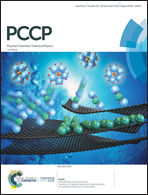Correlated magnetic field effects on carriers and excitons in single-carrier exciplex-based organic photodiodes†
Abstract
Magnetic field effects in nonmagnetic organic semiconductors (OMFEs) are attracting increasing attention because of the fingerprint characteristics of their line shapes when they are used to analyze the dynamic processes of organic photodiodes. However, the origin and correlation of OMFEs on carriers and excitons are currently still major challenges for researchers. In this study, we strategically designed exciplex-based single-carrier devices to effectively separate carriers and excitons and investigate their OMFEs and relationships. It is found that the obvious positive magneto-conductance (MC) with illumination is not only related to the formation of charge transfer state (CT) excitons, but is also caused by the secondary recombination process between dissociated carriers from the photo-generated excitons and the injected carriers. Moreover, a negative MC appears under dark conditions, reflecting the intrinsic magnetic field effects on carrier transport. The relationships of the OMFEs with the excitons and carriers were further studied by measuring the incident-wavelength dependent photo-induced MC and the magneto-photoluminescence (MPL) of the exciplex films. The two films show similar amplitude-dependent curves, which are contributed by their donor–acceptor absorption properties. Moreover, the strong triplet-polaron annihilation (TPA) processes exhibited in this device afford different amplitude-dependent photo-induced MCs.



 Please wait while we load your content...
Please wait while we load your content...